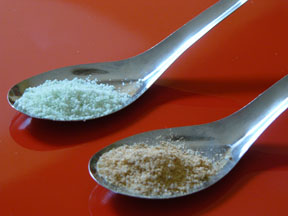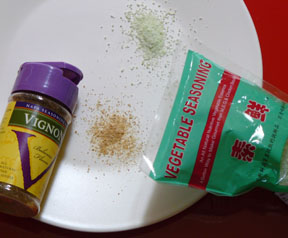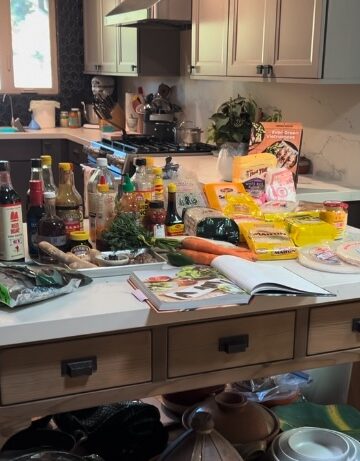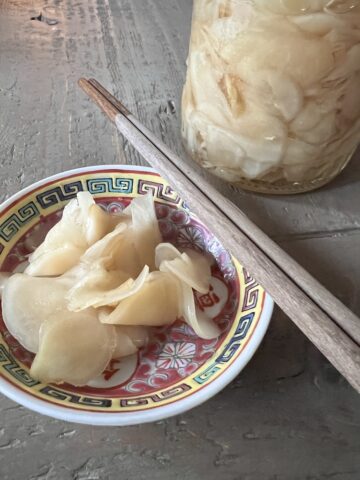Let’s face it. Asian cooks like to sprinkle a little monosodium glutamate (MSG) into their dishes as they cook. My mother has her jar of bồt ngọt (sweet powder) handy in the kitchen. She uses it sparingly and believes it gives her food a flavor boost. Some old school Vietnamese people swear that pho noodle soup isn’t authentic unless it has MSG in it.
It’s not necessarily a generational thing. Maki, my good friend and contemporary, grew up with a dispenser of Ajinomoto (the leading maker of the flavor enhancer) at her family’s Japanese table. “We sprinkled it on food like salt,” she said. Lord, we never lived like that. We just had the bottle of fish sauce on our table!
In older Asian cookbooks printed in the United States, MSG was a commonly-listed ingredient. Just a pinch was needed, and renowned food authorities like Florence Lin and Virginia Lee called for them in their recipes. Modern Asian cookbooks written and printed in Asia still include MSG in their recipes. If you read Vietnamese, you’ll see the ingredient listed as bồt ngọt or mì chính. When “chicken bouillon powder” is called for, that’s just a bit of MSG.
What is MSG? Technically, it’s the salt of an amino acid called glutamic acid and a form of glutamate. Amino acids are naturally occurring in our bodies and once linked up, they form proteins. In other words, we need amino acids to survive. However, I’m not sure if you need MSG to survive.
It’s been said that and excess amount of glutamates speeds up the speed at which messages are transmitted along our nervous system. Despite the fact that MSG has no flavor of its own, once the white powder is added to food, it magically makes you think that things taste extra good. You can’t get enough and keep slurping and going back for more. The messages are being relayed awfully fast up to your brain!The Japanese, who chemically developed MSG, say that it lends foods the savory deliciousness of umami -- the fifth taste alongside sweet, sour, salt, and better. More on umami in a bit.
Is using MSG so bad?
MSG is not really bad thing to use as a flavor enhancer, but when used too much in food as the source of flavor, MSG becomes a cheap trick. I remember growing up in Vietnam and people gossiping about so-and-so cook using too much MSG in his/her food. With a bit of the old white powder, you can stretch a small amount of ingredients to satisfy many. In Asia where populations are huge and resources are limited, MSG can be a life saver in the kitchen.
Some folks argue that manufactured MSG is not like naturally occurring MSG so the chemically produced crystals are not as safe as people think.
Fake MSG
I’ve never cooked with MSG but kinda crossed the line the other day with some fake MSG. Yes, that sounds like an oxymoron but it’s so post-modern isn’t it? A fake of a fake.
The powders I obtained were deemed to be all natural. The one from China, called Vegetable Seasoning, was the pale green and contained asparagus extract, carrot extract, western orchis (sic) extract, celery extract, salt, and amino acid (this last ingredient is a mystery). The other product, called Vignon, was developed by wine expert and taste educator Tim Hanni of Napa Seasoning Company. The tan powder is made from a bunch of ingredients, namely sea salt, natural flavors, yeast extract, maltodextrin, parmesan cheese, mushroom powder, garlic, and tomato powder.
Both of the flavor enhancers – or flavor balancer as Vignon frames it – taste nice on their own whereas MSG has no taste. I was making a vegetarian Chinese hot and sour soup last night and it needed just a little something so I added a pinch of the Chinese stuff and the soup tasted better.
Vignon claims that you can substitute it for salt or sprinkle it on just anything and it will pop the flavor. I just sprinkled some on brown rice and the rice took on a funny cheesy taste that I didn’t care for. Vignon says that it will help foods taste better with wine but I’m afraid it would alter the fundamental flavor of foods too much.
Umami-rich ingredients
Both of these fake MSG products employ ingredients like asparagus, carrot, tomato, parmesan cheese, and mushroom that have high levels of naturally occurring glutamate. So it’s not a fake fake but rather a natural fake of a fake. Got it.
Would I add these powders to my pantry? I don’t think so. They’re fun to fool with but I already cook with plenty of umami-rich ingredients. In the Vietnamese larder, staples such as the following introduce savory depth (yumminess) to foods:
- Fish sauce (nuoc mam)
- Shrimp sauce (mam tom)
- Dried shrimp
- Soy sauce
- Maggi Seasoning Sauce
- Oyster Sauce
- Dried shiitake mushroom
- Meat, poultry, and seafood
Many dried Asian foodstuffs such as dried shrimp, mushroom, scallop, seaweed, etc., are high in umami. Japanese cooks have it dialed in as dashi, their basic cooking broth made of seaweed and dried bonito flakes, is umami laden. If such ingredients comprise the ballast for your flavors, you don’t need extra help from enhancers and the like. However, it’s good to have a sense of how those ingredients build flavor in your food.
Related info:
- "If MSG is so bad for you, why doesn't everyone in Asia have a headache?" by Alex Renton of The Observer
- Umami Information Center
- Chinese restaurant syndrome symptoms and analysis by U.S. NIH Medical Encyclopedia
- Homemade umami salt on Eric Gower's Breakaway cook blog



















Kevin says
Really interesting post. I know the stuff's taboo, but really couldn't tell you why...so glad to hear more about it. I may just go out and buy some to understand it better!
As for Vignon, I heard of it on Wine Library TV, and felt the same way about it as I do about any other 'all purpose seasoning'. Glad to hear you confirm that.
Andrea Nguyen says
It's controversial but I figure why hide how people cook? Vignon is an interesting product -- yeast extract is a high glutamate ingredient.
Jacqueline says
Andrea: great post. I too grew up in a household (hapa) with ajinomoto on the stove next to the s&p. Now we know the anti-msg scare was a blown out of proportion - I had read the articles you cite. I also wanted to recommend the Kasabian's book (see link) and also a offer an alternative umami-salt instead of Chinese food products which I'm a little sketched out by...
One can create a natural, even organic, version of ajinomoto to keep on hand by blending salt with a bit of parmigiano-reggiano an
Lips says
My nanny used to make a instant seaweed eggy soup and the key ingredient was ajinomoto. And I simply nicknamed it ajinomoto soup 🙂 I think my mom must have fainted when I told her I love ajinomoto soup!!
Andrea Nguyen says
Jacqueline, yep, Eric Gower loves to use the electric spice grinder to make all kinds of seasonings. I added his post on making MSG salt to the post above.
Lips, ajinomoto soup... well, you didn't suffer because of it so the stuff doesn't harm nor kill.
Tuty says
You've "reintroduced" me to Maggi Seasoning Sauce (my mom had used this decades ago only for special occasions and I forgot about it)since I bought your beautiful cookbook. This flavour enhancing sauce has become indispensable in my house. Instead using steak sauce, my son uses Maggi Seasoning Sauce when he eats grilled steak. Thanks, Andrea.
arlette tran says
my family have allergy with MSG, which is like we have our facial muscle destroyed after consuming hot soup containing MSG. so it's quite scared when we try to taste street food in Northern Vietnam, like phở, bún or cháo.
at home we season our food with salt, soya sauce, and oyster sauce (though, we know oyster sauce contains MSG, but not so much, thank god!). but my grandmom's habit is putting as much MSG into food as she can. we couldn't totally eat her meal , though it's yummy 🙁
Andrea Nguyen says
Tuty, Maggi -- oh so good. I don't ask what's in it!
Arlette -- sounds like you're allergic to eating too much of the bot ngot. But who wants facial muscles to go bad? Yikes! I'm very sorry to hear that. You should be able to enjoy a little nuoc mam fish sauce, no? On the streets of Vietnam, I'm afraid that there is a lot of MSG used these days. Maybe try the more expensive vendors or restaurants? They may be using better ingredients and less MSG.
Andrea Nguyen says
Tuty, Maggi -- oh so good. I don't ask what's in it!
Arlette -- sounds like you're allergic to eating too much of the bot ngot. But who wants facial muscles to go bad? Yikes! I'm very sorry to hear that. You should be able to enjoy a little nuoc mam fish sauce, no? On the streets of Vietnam, I'm afraid that there is a lot of MSG used these days. Maybe try the more expensive vendors or restaurants? They may be using better ingredients and less MSG.
Pepy says
That is like bakso (meatballs noodle soup) in indonesia, MSG is common to use. Goshh, I recalled whenever I bought a bowl of bakso, I always ask no MSG added please.
somanabolic says
Monosodium glutamate (MSG) is the sodium salt of glutamic acid. Glutamate is a naturally occurring amino acid that is found in nearly all foods, especially high protein foods such as dairy products, meat and fish and in many vegetables. Foods often used for their flavouring properties, such as mushrooms and tomatoes, have high levels of naturally occurring glutamate.
Salt, also known as table salt, or rock salt, is a mineral that is composed primarily of sodium chloride. The manufacture and use
tacfit warrior review says
MSG is still bad for you in any quantity.
I used to think the same thing. Then someone told me that its a myth. So, I did some research.
Its not true. Salt is worse.
MSG mixed with salt can help you cut your intake by at least half and make your food taste better.
Bella says
I totally agree with the above writer, msg is soooooo less harmful than salt or sugar, there are more people dying of high blood pressure & diabetes than there r people dying of msg overdose. What's worse is there is a misconception about msg. Infact if it is soo bad than why r people not dying of eating red meat, fish mushroom tomatoes & Parmasen cheese. For crying out loud, the Italians have been putting p.cheese in just about all their foods n u don't hear anyone dying from it, and let's not
Bella says
And another thing, if someone's gone & extracted umami from meats which I would have had to slowly cook in large quanties for lobg periods and given it to me in a few sprinkles then that's a bonus cos let's face if sometimes time is a big factor in modern cooking. You either have it or u dont. We all use salt & sugar which r both manufactured then why can't msg b considered the same? At the end of the day we use flavour enhancers to tantalize our tastebuds & there are 2 ways of getting (1)natur
Beats by Dr Dre says
Men can think, feel, and sympathize with each other through their favorite author.
They live in him together, and he in them.
Canada Goose outlet says
Bad stuff, and it belongs at the bottom of the scale.
Red Bottom shoes sale says
All things are difficult before they are easy.
Beats by Dr Dre says
Don‘t put the cart before the horse.
Red Bottom shoes says
Every man hath his weak side.
Francesca says
I am deathly allergic to MSG, as are many people-- a fact that is rarely seen in print.
I have got anaphylactic shock from MSG three times. The first time in A Vietnamese restaurant; the second eating dim-sum (my favourite meal)-- I slumped, had a hard time breathing, my throat closed and I was extremely fortunate that there was an ambulance close by. I was taken to a hospital where an Asian doctor knew exactly what to do. I now have to carry an Epi-pen. It is the same as severe peanut allergies or shellfish allergies or bee sting.. It's life threatening.
What I did not expect: In Italy everyone seems to be sprinkling "chicken cubes" powder on everything from tomato sauce to sauteed spinach. I have had to be careful also with friend preparing dinner: a can of "chicken stock" has MSG as a first ingredient. It is not harmless. In the same way there is now awareness about nuts and nitrates and some antibiotics, this is a powerful allergen to some people. Please be careful!
Andrea Nguyen says
Thank you for sharing your experiences, Francesca. What an unfortunate situation to have to live and eat with!
How interesting that Italian cooks are using bouillon as a seasoning. I wonder if it's a Knorr product that's similarly popular in Latin America and Asia.
It is best to know what your body is sensitive to, and that sensitivity ranges from person to person. I have a chef friend who is allergic to seafood but every year, she tests to see if her body has changed enough to not be allergic. Our bodies can sometimes adapt. Life is mysterious and wonderful in that regard. Thanks again for weighing in!